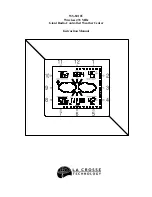
SR-1
–
17
TROUBLESHOOTING TIPS
If you experience difficulty, think of your SR-1 in its several sections or
stages: oscillator-mixer (NE602), IF audio and AGC, and final audio output
(LM386). The first step in case of problems is to make sure that the tunable
oscillator is working, which can be done by listening for its signal on another
receiver. After the oscillator circuit is confirmed working, standard signal
tracing procedures should isolate any problem, which will be either an
incorrectly-installed part, a defective part or a bad solder connection. Correct
orientation or polarity of all diodes, transistors, electrolytic capacitors and ICs
is essential.
PROBLEM:
Self-oscillation or motorboating
SOLUTION:
Be certain that C6 is a 4.7 to 10 µF. electrolytic and that R12 is
100K. A minor tendency toward oscillation may be noted when the Tuning
control is in an extreme position of its rotation, but this need not be a
problem if L2 is adjusted so that desired stations fall in the main rotation
range.
PROBLEM:
Strong shortwave broadcast audible throughout tuning range
SOLUTION:
This can occur if your antenna is "too good" or if the RF Gain
control is turned up too high. The high sensitivity of the NE602 front end is
designed for simple antennas, with most reception quite satisfactory with the
RF gain at its midpoint or so.
PROBLEM:
Local AM radio station audible throughout tuning range
SOLUTION:
Whether this will even happen depends on how close you are to
a local AM station. It is very important that all component leads be as short
as possible, since just a bit of wire can help D2 and the several stages of
audio amplification give you a free, unwanted "classic crystal radio". A
grounded metal case for the SR-1 is one possible solution. Another fix is to
solder a .001 µF capacitor in parallel with R10, so that it bypasses the anode
of D2 to ground. In theory, this would bypass ALL signals to ground, but this
solution has proven effective in two SR-1s constructed by the author.
PROBLEM:
Unstable, chirpy signals at higher speaker levels
SOLUTION:
Even in AM mode, signal "chirp" is distinguishable and is a sign
that current requirements of the IF and and audio stages are swinging the
voltage to the NE602 oscillator and varactor tuning. The receiver draws
about 200 mA. at peak audio volume, which means that a good fresh
alkaline battery is essential. If this poses a serious problem for pleasant
listening and your battery budget, consider an external battery supply (D
cells), AC power supply, or running the oscillator from its own 9-volt battery
as explained in the section for hams and experimenters. For casual listening
at moderate speaker volume, or earphone listening, the single 9-volt alkaline
Содержание SR-1
Страница 7: ...SR 1 7 SR 1 PARTS LAYOUT DIAGRAM...
Страница 20: ...SR 1 20 Notes...






































